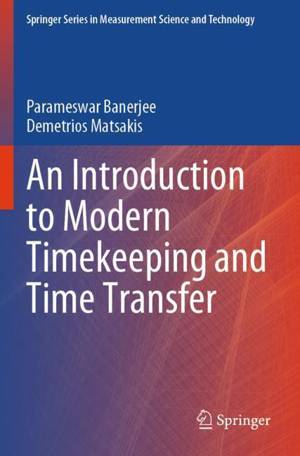
Je cadeautjes zeker op tijd in huis hebben voor de feestdagen? Kom langs in onze winkels en vind het perfecte geschenk!
- Afhalen na 1 uur in een winkel met voorraad
- Gratis thuislevering in België vanaf € 30
- Ruim aanbod met 7 miljoen producten
Je cadeautjes zeker op tijd in huis hebben voor de feestdagen? Kom langs in onze winkels en vind het perfecte geschenk!
- Afhalen na 1 uur in een winkel met voorraad
- Gratis thuislevering in België vanaf € 30
- Ruim aanbod met 7 miljoen producten
Zoeken
€ 144,45
+ 288 punten
Omschrijving
This book provides a comprehensive, systematic description of modern timekeeping and its specializations. Introductory chapters discuss the concept of time and its definition, then briefly look at pre-Atomic Era timekeeping to set the stage for the introduction of the atomic clock. Subsequent chapters focus on concepts such as frequency stability and measurement uncertainty, as well as computer network time-synchronization protocols including Network Time Protocol (NTP) and Precise Time Protocol (PTP). The book then delves into the nuts and bolts of the Global Navigation Satellite Systems (GNSS), Two-Way Satellite Time and Frequency Transfer, and Optical Time and Frequency Transfer. Timescale theory is then described as a way to combine clock data, and the algorithms and procedures used to generate Coordinated Universal Time (UTC) are given. Finally, there is a look at modern applications of timekeeping and time transfer.
Featuring a glossary of all key terms, this book is highly recommended for trained or incoming physicists, engineers, or mathematicians working, for example, in manufacturing or timing laboratories. Additionally, it is suitable for use in introductory university courses dealing with the subject of timekeeping.
Featuring a glossary of all key terms, this book is highly recommended for trained or incoming physicists, engineers, or mathematicians working, for example, in manufacturing or timing laboratories. Additionally, it is suitable for use in introductory university courses dealing with the subject of timekeeping.
Specificaties
Betrokkenen
- Auteur(s):
- Uitgeverij:
Inhoud
- Aantal bladzijden:
- 303
- Taal:
- Engels
- Reeks:
Eigenschappen
- Productcode (EAN):
- 9783031307829
- Verschijningsdatum:
- 17/09/2024
- Uitvoering:
- Paperback
- Afmetingen:
- 155 mm x 15 mm
- Gewicht:
- 552 g

Alleen bij Standaard Boekhandel
+ 288 punten op je klantenkaart van Standaard Boekhandel
Beoordelingen
We publiceren alleen reviews die voldoen aan de voorwaarden voor reviews. Bekijk onze voorwaarden voor reviews.









